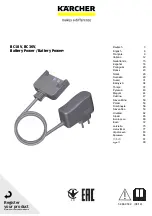
3
FUNCTIONAL
DESCRIPTION
1. Contacts
2. Tabs
3. Vents
4. Bay
5. Slots
Continuous red light: charging
Continuous green light: charging is complete
Flashing red light: battery is too hot or too cold -
charging will begin automatically when battery
reaches correct charging temperature
Flashing green and red light. Damaged or faulty
battery
6. Light indicator
6
3
5
4
2
1
SYMBOLOGY
Volts
Direct Current
Alternating Current
Double Insulated
Properly Recycle Batteries
Hertz
Amps
mA
Milliamps
C
US
UL Listing for Canada and U.S.
SPECIFICATIONS
Charger Cat. No. ................................ 48-59-2001
Input Volts AC
....................................................120
Input Milliamps...................................................300
Output Volts DC
.....................................................4
Output Amps ..........................................................3
Battery Cat. No. .................................. 48-11-2001
Volts DC
.................................................................4
M4™ LITHIUM-ION
BATTERY
WARNING
To reduce the risk of fire, personal
injury, and product damage due to
a short circuit, never immerse your tool, battery
pack or charger in fluid or allow a fluid to flow
inside them. Corrosive or conductive fluids, such
as seawater, certain industrial chemicals, and
bleach or bleach containing products, etc., can
cause a short circuit.
Maintenance and Storage
Do not expose your battery or cordless tools to water
or rain, or allow them to get wet. This could damage
the tool and battery. Do not use oil or solvents to
clean or lubricate your battery. The plastic casing
will become brittle and crack, causing a risk of injury.
Store batteries at room temperature away from mois-
ture. Do not store in damp locations where corrosion
of terminals may occur. As with other battery types,
permanent capacity loss can result if the battery is
stored for long periods of time at high temperatures
(over 120° F). MILWAUKEE Lithium-Ion batteries
maintain their charge during storage longer than
other battery types. After about six months of storage,
charge the battery as normal.
WARNING
To reduce the risk of injury or ex-
plosion, never burn or incinerate a
battery pack even if it is damaged, dead or com
-
pletely discharged. When burned, toxic fumes
and materials are created.
Disposing of MILWAUKEE Lithium-Ion
Battery Packs
MILWAUKEE Lithium-Ion battery packs are more
environmentally friendly than some other types of
power tool battery packs (e.g., nickel-cadmium).
Always dispose of your battery pack according to
federal, state and local regulations. Contact a re-
cycling agency in your area for recycling locations.
Even discharged battery packs contain some energy.
Before disposing, use electrical tape to cover the
terminals to prevent the battery pack from shorting,
which could cause a fire or explosion.
RBRC Battery Recycling Seals
The RBRC™ Battery Recycling Seals (see "Sym-
bology") on your tool battery packs indicate that
MILWAUKEE has arranged for the recycling of
that battery pack with the Rechargeable Battery
Recycling Corporation (RBRC). At the end of your
battery pack's useful life, return the battery pack to
a MILWAUKEE Branch Office/Service Center or
the
participating retailer nearest you.






















